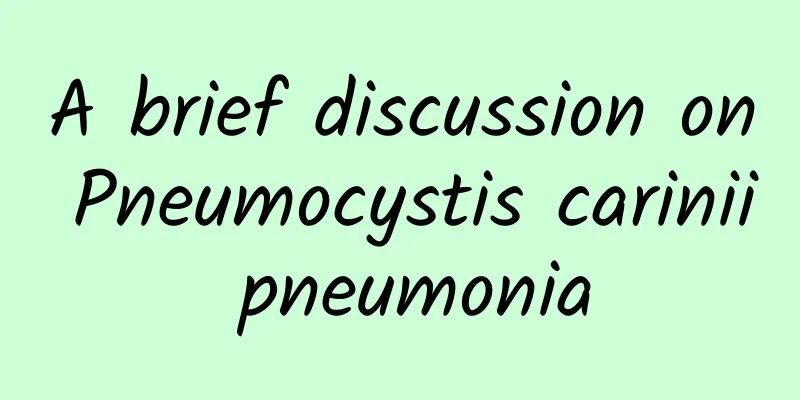A brief discussion on Pneumocystis carinii pneumonia

|
This is the 3776th article of Da Yi Xiao Hu What is Pneumocystis carinii pneumonia (PCP)? Pneumocystis pneumonia, referred to as PCP, is also known as Pneumocystis carinii pneumonia and Pneumocystis carinii pneumonia. It is an interstitial plasma cell pneumonia caused by Pneumocystis carinii and is a conditional lung infection. Before the 1950s, this disease was only seen in premature infants and malnourished infants. In the past decade, with the application of immunosuppressants, the popularization of tumor chemotherapy, and especially the emergence of human immunodeficiency virus (HIV) infection, the incidence of PCP has increased significantly and has become the most common opportunistic infection and the main cause of death in HIV-infected patients. The clinical manifestations of PCP are mainly divided into ① Popular type It mainly occurs in premature infants, infants with malnutrition, and infants with congenital immunodeficiency. This type of disease has a slow onset, first with anorexia, diarrhea, and low fever, followed by coughing and dyspnea. The symptoms are progressively aggravated, and the mortality rate without treatment is 20% to 50%. ②Dispersed type (modern type) There are children and adults with a relatively rapid onset, with dry cough at the beginning, and rapid onset of high fever, shortness of breath, cyanosis, and progressive dyspnea as its important clinical manifestation, while there are few lung signs, and there may be hepatosplenomegaly. From onset to diagnosis, patients with typical manifestations can be diagnosed within 1 to 2 weeks, while patients with atypical manifestations often have delayed diagnosis, which affects the prognosis. Patients who receive high-dose hormone treatment have a short course of disease and may die in 4 to 8 days. The symptoms of this disease are severe, but there are few lung signs. Most patients have no abnormalities in lung auscultation, and the mortality rate without treatment is almost 100%. 3. Main treatment methods ① General treatment Although the mortality rate of this disease is high, if it can be diagnosed and treated early, it will have a good treatment response and most patients can recover. Patients should rest in bed, strengthen nutrition, correct water and electrolyte disorders, and actively receive oxygen therapy if they have difficulty breathing, and inhale oxygen through the nose or mask. For those with severe hypoxia, non-invasive ventilator-assisted ventilation is the first choice. For those with poor results, endotracheal intubation or tracheotomy is required for invasive ventilator-assisted ventilation. However, since most of these patients are immunosuppressed, the incidence of ventilator-associated pneumonia is high, which seriously affects the prognosis. At present, there are also many successful cases of extracorporeal membrane oxygenation (ECMO) treatment in China. For patients with AIDS and Pneumocystis pneumonia and severe diffuse pulmonary lesions, it is recommended to actively use glucocorticoids, such as prednisolone, methylprednisolone, etc.; but for non-AIDS patients with Pneumocystis pneumonia, whether to use glucocorticoids requires doctors to make specific judgments based on the specific conditions of the patients. ②Treatment of the cause The first choice of antibiotics is sulfamethoxazole/trimethoprim (compound sulfamethoxazole, TMP/SMZ), and pentamidine, atovaquone, and benquine/clindamycin can also be used alone or in combination according to individual differences. However, due to regional and drug supply issues, caspofungin combined with clindamycin has also become an alternative in clinical applications. IV. Efficacy evaluation and prognosis judgment Close observation and dynamic evaluation are required during treatment. Some patients will continue to have worsening symptoms in the early stage of treatment, which is not considered as a basis for ineffective treatment. Clinical evaluation is generally chosen after one week of treatment. No improvement after 8 days of treatment indicates a poor prognosis. Overall, this type of patient has a poor prognosis and a high mortality rate, which may be related to the original underlying disease and the easy and difficult to control mixed infection under immunosuppression. 5. How to prevent Pay attention to the isolation of immunosuppressed persons and patients to prevent cross infection. For patients at risk of Pneumocystis carinii pneumonia, drug prevention can be used to effectively prevent latent infection from turning into clinical disease and recurrence after treatment. Author: Emergency Department, The Second Affiliated Hospital of Xi'an Jiaotong University Chief Physician Pei Honghong guides Emergency Department, The Second Affiliated Hospital of Xi'an Jiaotong University Written by Nurse Zheng Xin |
Recommend
What are the abnormal leucorrhea?
There are many women who are usually careless and...
Counterpoint: Global smartphone shipments are expected to reach 1.2 billion units in 2024, a slight rebound of 3% year-on-year
Research firm Counterpoint Research predicts that...
How can pregnant women tell if they are about to give birth?
Generally speaking, during the first prenatal che...
Are the pathologies of pelvic effusion and pelvic inflammatory disease different?
When people have pelvic inflammation and pelvic e...
What are the characteristics of influenza A? Should antiviral drugs be used? Expert answers
Xinhua News Agency, Beijing, March 13th , Title: ...
The best time to review after abortion
As we all know, abortion can damage the uterus of...
World Sepsis Day 2024: Deepen cognition, optimize diagnosis and treatment, and build a healthy future together
September 13, 2024 is the 13th World Sepsis Day. ...
How to solve chest pain and lumps
Female friends may be more familiar with the situ...
Can the abortion be detected two years later?
Abortion refers to a method in which a woman feel...
What is the reason for the three miscarriages?
Pregnancy is the phenomenon that women pay the mo...
Can diet really improve pregnancy rates?
Improving the pregnancy rate is one of the issues...
How to choose mooncakes for Mid-Autumn Festival? Five things to know about eating mooncakes
Key Points ★ When choosing mooncakes, check the n...
I'm not angry, if I get breast hyperplasia...
I believe many people have heard the saying "...
Precautions for having sex during childbirth
Regardless of whether women give birth naturally ...
Will delaying my period affect my pregnancy?
Nowadays, many women are rather careless, especia...


![[2023 "Science Popularization China Youth Star Creation Competition"] Human Model Worker - Liver Repair Manual](/upload/images/67f1808cd036a.webp)






